You can easily say that Clownfish are one of the most beloved types of fish in the saltwater aquarium hobby. Great personality, fun to watch, easy on the budget yet so exotic and beautiful. The kids love it too of course.
There truly is a clownfish for everyone. You can choose between different types of Clownfish with various colorations, patterns, size, and temperaments. In fact, I am confident that every fish keeper will find a variation suitable for their needs.
Something else clownfish are known for, of course, is their relationship with the sea anemone. They are in symbiosis which is beneficial to both organisms involved.
In this guide, I will mostly focus on the six main groups known as complexes. And while you probably won’t keep most of the fish listed in this article, you should at least have a basic understanding of which type belongs in which complex, so you can make an optimal environment in your tank for the fish.
More importantly, this guide will help you narrow your options and make the best decision when buying a new clownfish.
Types of Clownfish that can be kept in your aquarium: Species Guide
As I mentioned earlier in this guide, all 30 clownfish species are divided into 6 Complexes. Each of them is different from some characteristics and attributes. These are the main 6 groups:
- Skunk Complex
- Tomato Complex
- Saddleback Complex
- Clarkii Complex
- Maroon Complex
- Percula Complex
Without further ado, let’s explain every complex individually.
Skunk Complex- 2 Species
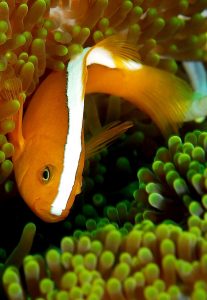
The Skunk Complex is the second largest type of Clownfish after the Clarkii. The following types of Clownfish are not the common ones you are more likely to find in your local fish shops. It’s probably the most interesting and unique out of the other six complexes. As indicated by the name, these types of Clownfish have a long white stripe that runs down the length of their backs.
However, that’s not the only thing that set apart this complex from the other five. There are other characteristics and attributes unique only for the Skunk Complex.
If you are an aquarist that wants something different than the regular clownfish than maybe this is your type. They are the smallest species of this subfamily but that doesn’t mean they are difficult to keep in captivity. In fact, their small size could be perfect for nano aquariums. However, they are quite timid and suitable tankmates must be picked for them to thrive in their full potential. Predatory fish should be excluded in this setup.
As the availability of this type, there is nothing I can say about. If your local fish shop doesn’t have in stock, then buying online is your best choice.
Tomato Complex- 2 Species
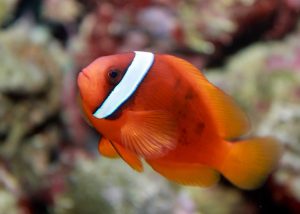 This complex may not be the prettiest by any means, but certainly, it’s the hardiest. Tomato clownfish Complex is the third largest type after the Clarkii and Skunk Complexes. These types of fish are one of the most durable in the aquarium hobby.
This complex may not be the prettiest by any means, but certainly, it’s the hardiest. Tomato clownfish Complex is the third largest type after the Clarkii and Skunk Complexes. These types of fish are one of the most durable in the aquarium hobby.
Why does this matter? Aside from the fact that is not the most attractive type most hobbyists want, it might be a good choice for beginners.
They are relatively easy for breeding and one of the most common types found in the saltwater aquarium hobby. These species have less attractive patterns than the others. They only have just one white band, that is located behind the eye. However, that’s not making them less special.
Here is the great thing about Tomato Clownfish.
As I mentioned before in this article they are quite durable, hardy fish with rugged and fearless character. In other words, perfect beginner saltwater fish. They can survive ammonia spikes, tolerate bad water quality and poor nutrition. But, it doesn’t mean that you should neglect them. They deserve great tank conditions as any other fish.
Tomato complex is great as community fish that can live with other more aggressive species without a problem. You can arguably say they are the best choice for novice or even advanced aquarist.
Saddleback Complex- 3 Species
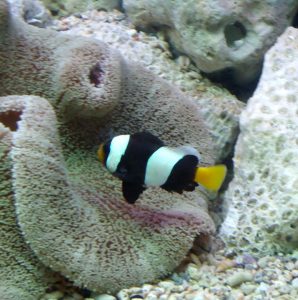 I would say that out of these 6 groups, the Saddleback Complex is the most challenging species to keep alive in captivity. There are three members in this subfamily, the wind-band clownfish, the saddleback clownfish, and sebae clownfish.
I would say that out of these 6 groups, the Saddleback Complex is the most challenging species to keep alive in captivity. There are three members in this subfamily, the wind-band clownfish, the saddleback clownfish, and sebae clownfish.
They get their name from the white stripes that appear as saddles across their back. Another distinguishing characteristic of this type is their dark color. And they are larger than most of the other clownfish species.
If you are not advanced aquarist and have at least a couple of years in experience I would not advise you to purchase these fish. You will certainly encounter some problems even if you are experienced, fish keeper.
For most of us, is not worth the trouble. Yes, these fish are more rare and exotic than the classic clownfish you will see in your local fish shop or in online shops, making them more expensive to purchase.
However, if you do end up with a Saddleback clownfish, it’s important to take proper care of it. You will need at least a 40-gallon tank. Larger is always better.
Since they are so skittish, make sure there are enough places for hiding in the aquarium. The lights should never be suddenly turn on or off. Gradually increasing or decreasing is the best practice. A hood on the top of the tank is a must to prevent jumping. Choosing a less frequent area for the tank is also a good idea.
If you’re willing to put up the work and provide an excellent condition for this type you will certainly have success. Beware of scammers in the aquarium trade business that sell Saddleback that actually is clownfish from the Clarkii Complex. Do the research first and you are good to go.
Clarkii Complex- 11 Species
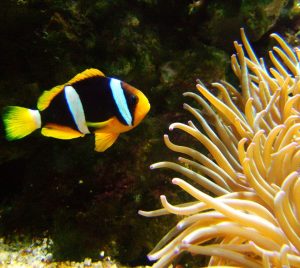 The Clarkii Complex is the largest of the six main groups. There 11 Species recognized in this group with Clark’s Clownfish as the most common in the aquarium trade. However, Three-Band is the most desirable type, and the rarest to find.
The Clarkii Complex is the largest of the six main groups. There 11 Species recognized in this group with Clark’s Clownfish as the most common in the aquarium trade. However, Three-Band is the most desirable type, and the rarest to find.
There are similarities between the species in this complex but each one has a certain uniqueness. These fish are among the easiest clownfish to care for. They are hardy, with beautiful patterns and can grow up to 5.1 inches.
They are bred in captivity and you can easily find them in your local fish shop. Be careful when selecting tankmates. They can be territorial and aggressive towards similar species.
Maroon Complex- 2 Species
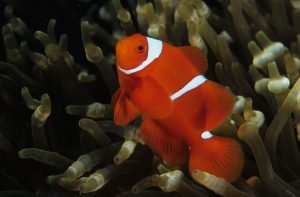 Some of the most recognized fish in the saltwater aquarium hobby is the Maroon Clownfish from the Maroon Complex. It’s known as the largest clownfish that can grow up to 6.3 inches (16 centimeters).
Some of the most recognized fish in the saltwater aquarium hobby is the Maroon Clownfish from the Maroon Complex. It’s known as the largest clownfish that can grow up to 6.3 inches (16 centimeters).
It is found mostly in lagoons in the Indo Pacific region. This species usually has a deep red base with white stripes. The one with gold stripes is found only in Sumatra.
These fish are very hardy and recommended for beginners. However, as any other fish providing a healthy environment is the best practice to ensure longevity.
The biggest concern with this type is their aggressiveness. They are very territorial and mean towards other species. Keep that in mind when selecting tankmates.
Maroon Clownfish are easy to find in aquarium shops with decent price unless you are looking for unusual patterns.
Percula Complex- 4 Species
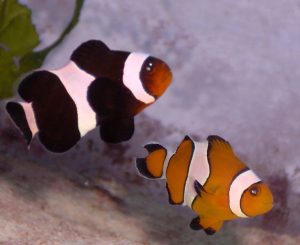 Chances are that you will find clownfish from this complex in every store that sells saltwater fish. It’s the most popular and common clownfish. It’s recognized even by those who have never own an aquarium.
Chances are that you will find clownfish from this complex in every store that sells saltwater fish. It’s the most popular and common clownfish. It’s recognized even by those who have never own an aquarium.
You can easily say that it’s the icon of the saltwater aquarium hobby. It is found in lagoons and corals reefs in the Western Pacific Ocean. It has a basic orange base with white stripes and is one of the smallest types of Clownfish.
Known as the first captive-bred clownfish this fish comes in different varieties and forms. These days most aquarists want specific patterns and certain uniqueness. With the increasing commercial breeding, there is a type for everyone.
However, you gotta appreciate the beauty the wild forms offer. After all, is a personal choice.
Pictures credit: 1. 2. 3. 4. 5. 6.
References and further reading
1.https://www.advancedaquarist.com/2012/4/fish
2.https://www.advancedaquarist.com/2011/9/fish
3.https://en.wikipedia.org/wiki/Amphiprioninae
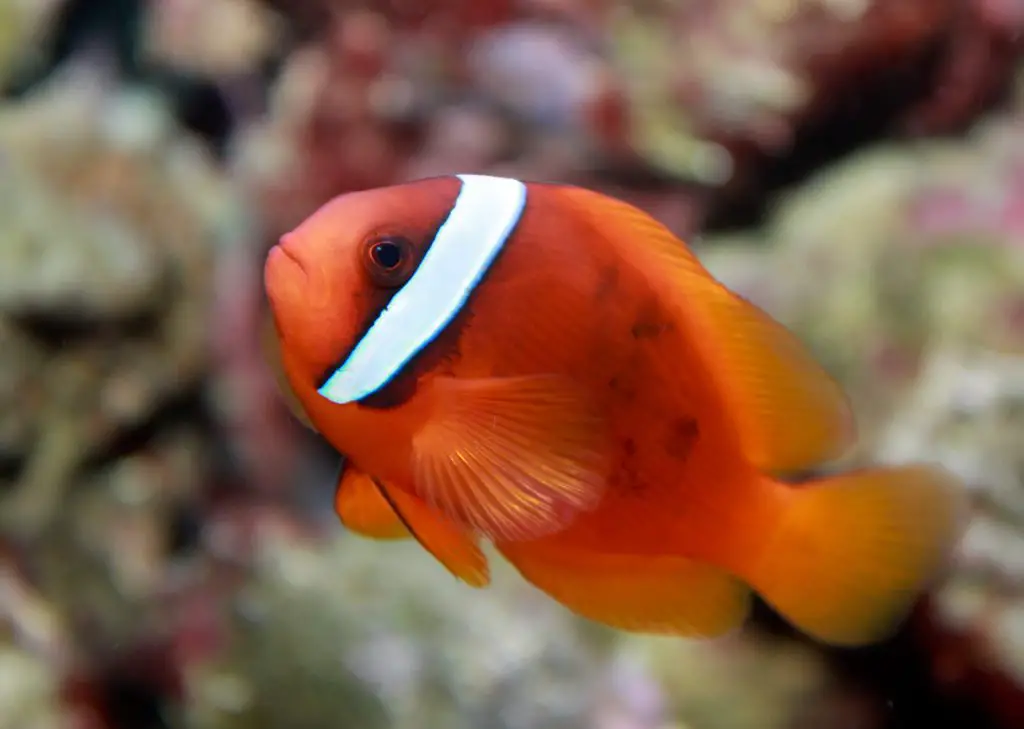
this is awsome